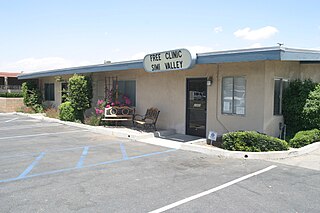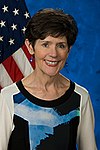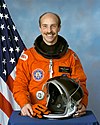
A medical guideline is a document with the aim of guiding decisions and criteria regarding diagnosis, management, and treatment in specific areas of healthcare. Such documents have been in use for thousands of years during the entire history of medicine. However, in contrast to previous approaches, which were often based on tradition or authority, modern medical guidelines are based on an examination of current evidence within the paradigm of evidence-based medicine. They usually include summarized consensus statements on best practice in healthcare. A healthcare provider is obliged to know the medical guidelines of his or her profession, and has to decide whether to follow the recommendations of a guideline for an individual treatment.
The Joint Commission is a United States-based nonprofit tax-exempt 501(c) organization that accredits more than 22,000 US health care organizations and programs. The international branch accredits medical services from around the world. A majority of US state governments recognize Joint Commission accreditation as a condition of licensure for the receipt of Medicaid and Medicare reimbursements.
The Agency for Healthcare Research and Quality is one of twelve agencies within the United States Department of Health and Human Services (HHS). The agency is headquartered in North Bethesda, Maryland, a suburb of Washington, D.C.. It was established as the Agency for Health Care Policy and Research (AHCPR) as a constituent unit of the Public Health Service (PHS) under the Omnibus Budget Reconciliation Act of 1989, December 19, 1989, to enhance the quality, appropriateness, and effectiveness of health care services and access to care by conducting and supporting research, demonstration projects, and evaluations; developing guidelines; and disseminating information on health care services and delivery systems.

A free clinic or walk in clinic is a health care facility in the United States offering services to economically disadvantaged individuals for free or at a nominal cost. The need for such a clinic arises in societies where there is no universal healthcare, and therefore a social safety net has arisen in its place. Core staff members may hold full-time paid positions, however, most of the staff a patient will encounter are volunteers drawn from the local medical community.
Computerized physician order entry (CPOE), sometimes referred to as computerized provider order entry or computerized provider order management (CPOM), is a process of electronic entry of medical practitioner instructions for the treatment of patients under his or her care.
Patient safety is a discipline that emphasizes safety in health care through the prevention, reduction, reporting, and analysis of medical error that often leads to adverse effects. The frequency and magnitude of avoidable adverse events experienced by patients was not well known until the 1990s, when multiple countries reported staggering numbers of patients harmed and killed by medical errors. Recognizing that healthcare errors impact 1 in every 10 patients around the world, the World Health Organization calls patient safety an endemic concern. Indeed, patient safety has emerged as a distinct healthcare discipline supported by an immature yet developing scientific framework. There is a significant transdisciplinary body of theoretical and research literature that informs the science of patient safety.
A patient safety organization (PSO) is a group, institution, or association that improves medical care by reducing medical errors. Common functions of patient safety organizations are data collection and analysis, reporting, education, funding, and advocacy.
John J. Nance is an American pilot, attorney, aviation and healthcare safety analyst, and author. He was born in Dallas, Texas.
In healthcare, a change-of-shift report is a meeting between healthcare providers at the change of shift in which vital information about and responsibility for the patient is provided from the off-going provider to the on-coming provider. Other names for change-of-shift report include handoff, shift report, handover, or sign-out. Change-of-shift report is key to inpatient care because healthcare providers are essential to providing around the clock care.

Martin "Marty" Makary is an American surgeon, New York Times bestselling author, and Johns Hopkins health policy expert. He has written for The Wall Street Journal,USA Today, TIME,Newsweek, and CNN, and appears on NBC and Fox News. He is the author of The Price We Pay, a book about how business leaders and families can lower their health care costs and the grass-roots movement to restore medicine to its mission. Dr. Makary practices surgical oncology and gastrointestinal surgery at the Johns Hopkins Hospital and teaches public health policy at the Johns Hopkins Bloomberg School of Public Health. Makary works in health care innovation, quality measurement science, frail and vulnerable populations, and public health disparities. He served in leadership roles at the United Nations World Health Organization for the Safe Surgery Saves Lives initiative. Makary was named one of the most influential people in healthcare by Health Magazine. In 2018, Makary was elected to the National Academy of Medicine.
Consumer Assessment of Healthcare Providers and Systems (CAHPS) refers to a set of surveys that ask patients to report on their health care experiences. The surveys are free to anyone who wants to use them. They focus on aspects of healthcare quality that patients find important and are well-equipped to assess, such as the communication skills of providers and ease of access to healthcare services.
Health care quality is a level of value provided by any health care resource, as determined by some measurement. As with quality in other fields, it is an assessment of whether something is good enough and whether it is suitable for its purpose. The goal of health care is to provide medical resources of high quality to all who need them; that is, to ensure good quality of life, cure illnesses when possible, to extend life expectancy, and so on. Researchers use a variety of quality measures to attempt to determine health care quality, including counts of a therapy's reduction or lessening of diseases identified by medical diagnosis, a decrease in the number of risk factors which people have following preventive care, or a survey of health indicators in a population who are accessing certain kinds of care.

David Bates is an American-born physician, biomedical informatician, and professor, who is internationally renowned for his work regarding the use of health information technology (HIT) to improve the safety and quality of healthcare, in particular by using Clinical Decision Support. Dr. Bates has done especially important work in the area of medication safety. He began by describing the epidemiology of harm caused by medications, first in hospitalized patients and then in other settings such as the home and nursing homes. Subsequently, he demonstrated that by implementing computerized physician order entry (CPOE), medication safety could be dramatically improved in hospitals. This work led the Leapfrog Group to call CPOE one of the four changes that would most improve the safety of U.S. healthcare. It also helped hospitals to justify investing in electronic health records and in particular, CPOE. Throughout his career, Bates has published over 600 peer reviewed articles and is the most cited researcher in the fields of both patient safety and biomedical informatics, with an h-index of 115. In a 2013 analysis published by the European Journal of Clinical Investigation, he ranked among the top 400 living biomedical researchers of any type. He is currently Editor of the Journal of Patient Safety.
National Quality Forum (NQF) is a United States-based non-profit membership organization that promotes patient protections and healthcare quality through measurement and public reporting. It was established in 1999 based on recommendations by the President's Advisory Commission on Consumer Protection and Quality in the Health Care Industry. NQF’s membership comprises over 400 organizations, representing consumers, health plans, medical professionals, employers, government and other public health agencies, pharmaceutical and medical device companies, and other quality improvement organizations. NQF has helped develop guidelines on palliative care.
Patient satisfaction is a measure of the extent to which a patient is content with the health care which they received from their health care provider.
Nancy (Crane) Conrad is a teacher, author, publisher, entrepreneur, and public speaker. She is the wife of late astronaut Pete Conrad and Founder and Chair of the Conrad Foundation.
Surfing the Healthcare Tsunami: Bring Your Best Board is a made for television documentary that explores medical errors and waste in healthcare. It was broadcast globally on the Discovery Channel in 2012. It references federally-funded studies in the United States and news footage to support the claim that healthcare workers are afraid to speak up when medical errors occur in hospitals. The documentary covers solutions to preventable system failures causing harm. It aired four times on the Discovery Channel commercial-free in North America, Germany, the U.K., France, and other Western European countries including Sweden. It premiered at the National Press Club on April 27, 2012 after a short speech by Captain Sully Sullenberger who was featured in the film. The film was screened at the Texas Health Care Quality Improvement Awards on May 3, 2012. The title “Surfing the Healthcare Tsunami: Bring Your Best Board” is a registered trademark owned by HCC Corporation.
Learning health systems (LHS) are healthcare systems in which knowledge generation processes are embedded in daily practice to produce continual improvement in care.
The Medical Tactical Certificate Training Program also known as Med Tac, is a global bystander rescue care training program that focuses on life saving actions that can be performed by non-medical bystanders for the 8 leading preventable causes of death to children, youth, and adults. In urban areas in the United States, professional first responders arrive at the scene of an emergency after approximately 10 minutes. Yet immediate rescue care by bystanders within three minutes of an event has been found to have an enormous impact on survival and permanent harm. Spawned and accelerated after the dramatic increase in active shooter and terrorism events, it integrates the American Heart Association Heartsaver CPR/AED Training Program or the American Red Cross equivalent training and the Stop the Bleed Program sponsored by the United States Department of Homeland Security and American College of Surgeons.




























